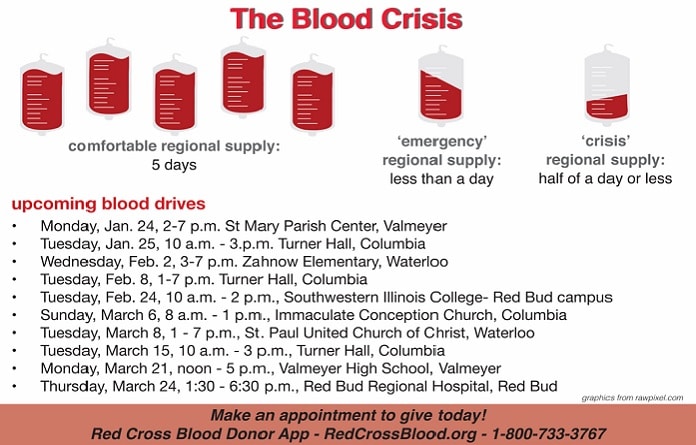Blood shortage at crisis level

The American Red Cross has declared its first ever blood crisis as it battles the worst blood shortage in over a decade.
Joe Zydlo serves as Red Cross’ regional communication manager for Missouri, Arkansas and portions of southwest and southeastern Illinois. He explained that in order to comfortably supply the region and other areas should there be a need, the Red Cross needs a five-day supply of blood products.
Now, the organization only has a half-day supply, sometimes even less.
“We partner with a lot of different hospitals and across our region and across the nation and when you don’t have a full assortment of blood products that you can provide for the hospitals that you partner with, they have to make difficult decisions on who is going to receive blood transfusions (and) who is going to have to wait for more products to become available. These are life-saving procedures … it could be the difference between life and death,” Zydlo said.
Zydlo explained that during the spring and summer of 2020, many individuals “stepped up” as donating blood was one of the largest ways they could help with the new pandemic. But as life started returning to somewhat normal, donors waned.
Prior to the pandemic, 18-25 percent of American Red Cross blood drives were held at schools, Zydlo said. With the pandemic, these opportunities became less common.
“Some schools were pausing blood drives – they wanted to be a little more cautious by maybe not bringing outside organizations in due to COVID,” Zydlo said.
As 2021 came to a close, things got worse.
“Then, of course, we have the situation where you have the holidays, Thanksgiving and then all the holidays in December, and people don’t really think of donating blood,” Zydlo said, adding that COVID-19 and seasonal illnesses lead to less donors and staff shortages limiting drives.
“So it’s really a perfect storm; there are so many factors that are kind of adding to this … to where we’re struggling so much,” he said.
Yet, Zydlo said with enough help, there is a solution.
“Now, how do we get out of this dire situation? We need people to not only make appointments, but we need people to follow through and honor those appointments,” Zydlo said. “We know it’s going to be challenging with winter weather and cold and flu season. This latest COVID strain is obviously putting another wrinkle into everything. We’re just telling people if you’re healthy and eligible to donate, make that appointment and get in as soon as you can.”
For the most updated information on appointment availability – especially as drive dates may change with inclement weather – Zydlo said to check redcrossblood.org and the Red Cross Blood Donor App.
On this app, donors can complete a health history screening before arriving at the donation center. Zydlo said this can save approximately 15 minutes in line. One can also track the progress of their blood after donating, seeing when it is being lab tested and where it goes.
Zydlo said that when individuals donate in the region Monroe County is included in, there are 80 hospitals their blood could go to. Should this region return to a five-day supply, it could be sent to states outside the region, too.
“Sometimes my blood goes to St. Louis, there’s been times where it’s gone to the Children’s Hospital in Columbia, Mo., which is great. I just want to help somebody, just like I would want somebody to help me or a loved one if they needed it,” he said.
To ensure the safety of donors, volunteers and staff, masks and social distancing is required. Beds are being wiped down more frequently, and the Red Cross engages in contact tracing efforts.
“When people come to a blood drive, regardless of vaccination status, everybody has to wear a mask,” Zydlo said. “It’s just been a universal policy for us … and the reason for that is that we can’t keep up with what each county or state or community’s rules are as far as masks or no masks, so we just said ‘You know what, we’re gonna do a universal policy for all of our donors, our staff and our volunteers just to be safe.’”
Should a potential donor test positive for COVID-19, they cannot donate until two weeks after they test negative.
“Once you’ve recovered from COVID and you get that negative test, wait two more weeks – 14 days – before you come and donate,” Zydlo said.
If one ends up testing positive shortly after donating blood, it is important they inform the Red Cross.
“If we’re notified and stuff, that blood won’t go to anyone. We can trace that back to make sure that people don’t get that,” Zydlo said. “But again, you’re really relying on people to be honest about it and that’s not always the case, but you’re sort of going by an honesty policy of saying if people aren’t feeling well they won’t come.”






